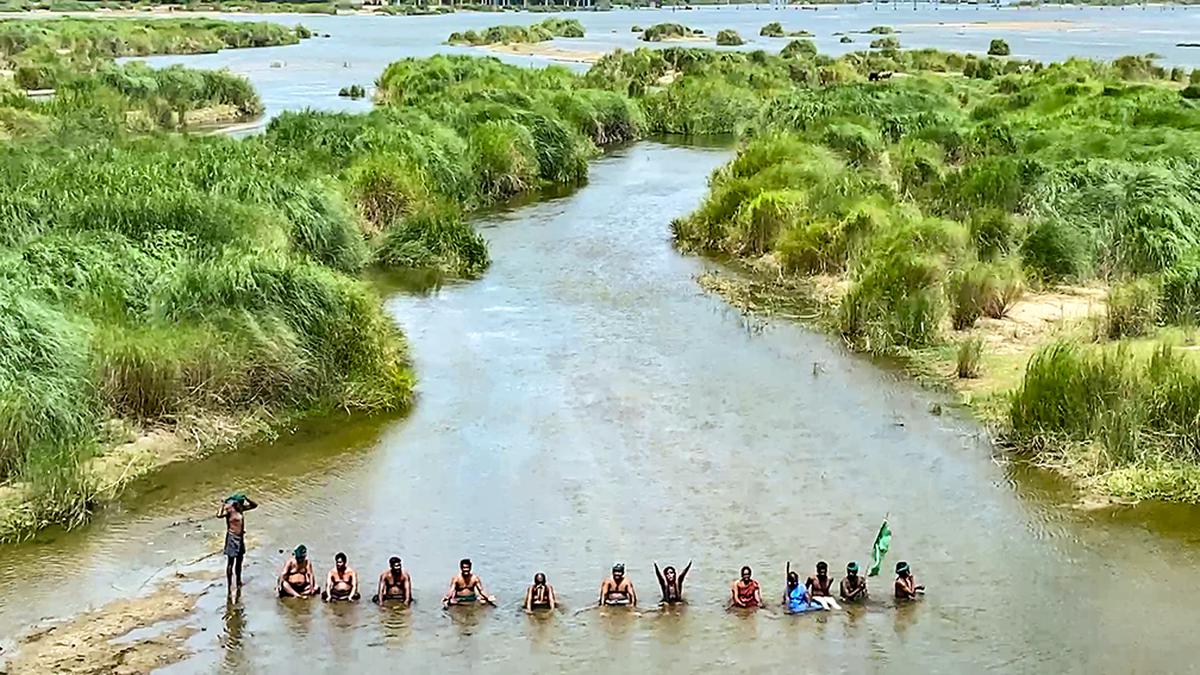
Explained | The Cauvery water conundrum
The Hindu
Karnataka and Tamil Nadu in dispute over Cauvery water; SC asked Karnataka to release 5,000 cusecs for 15 days; activists arrested; shops closed; coalition calls for Bengaluru bandh; CWDT's 2007 award and SC's 2018 judgment spell out sharing system; 740 tmc ft available in basin; TN needs water for irrigation, drinking; CWMA should take initiative to evolve distress-sharing formula.
The story so far: On September 21, the Supreme Court asked Karnataka to continue releasing 5,000 cubic feet per second (cusecs) of water from the Cauvery river to Tamil Nadu for 15 days, in line with decisions of the Cauvery Water Regulation Committee (CWRC) and the Cauvery Water Management Authority (CWMA). This has evoked a strong reaction from certain sections of Karnataka, an upper riparian State.
On September 22, the police arrested activists of the Federation of Karnataka Farmers’ Associations in Mysuru as they tried to barge into the Mysuru Zilla Panchayat premises to gherao Urban Development Minister Byrathi Suresh. The next day, several shops and business establishments remained closed in Mandya. A coalition of farmers and Kannada organisations have called for a bandh in Bengaluru on September 26, where the CWRC is scheduled to meet and review the situation of water availability and release.
The Cauvery Water Disputes Tribunal (CWDT)’s final award of 2007 and the Supreme Court’s judgment of February 2018 spell out the system for sharing the river water and the institutional mechanisms for ensuring implementation of the judicial verdicts. Pointing out that 740 thousand million cubic feet (tmc ft) of water would be available in the Cauvery basin in a normal year, the Court, which broadly adhered to the CWDT’s award, made the allocation for constituents of the basin as follows: Karnataka (284.75 tmc ft); Tamil Nadu (404.25 tmc ft); Kerala (30 tmc ft) and Puducherry (7 tmc ft). Ten tmc ft and four tmc ft have been set apart for environmental protection and inevitable escapages into the sea.
Of Tamil Nadu’s overall allocated quantity, Karnataka is to ensure 177.25 tmc ft, as per a monthly schedule, at Biligundulu, located on the inter-State border. Of this quantity, 123.14 tmc ft is to be given during the period from June to September, also marking the season of the southwest monsoon. Invariably, it is during this period that the Cauvery issue gets flared up, as the monsoon sometimes yields lower rainfall than anticipated.
The CWMA and its assisting body, CWRC, are in existence since June 2018 to oversee the implementation of the verdicts of the Tribunal and the Court.
This year’s southwest monsoon has played truant, especially in south interior Karnataka, the region where the Cauvery river originates. Between June 1 and September 23, the region suffered a deficit rainfall of 27%, according to the India Meteorological Department. Kodagu of Karnataka and Wayanad of Kerala, which form part of the catchment of the Cauvery and its tributary, Kabini, registered a deficit rainfall of 43% and 56% respectively. Karnataka, in its application before Court, had stated that “...at the reservoir level, which covers a part of the catchment, the shortfall is 53.42%,” given the fact that the State has four reservoirs in the Cauvery basin.
Last week, Karnataka told the Supreme Court that the daily flow of 5,000 cusecs of water to Tamil Nadu was “against [its] interest.” The State, especially in urban areas like Bengaluru, was on “the brink of a drinking water crisis” whereas Tamil Nadu was in need of water for irrigation. It also added that the distress in Karnataka had increased in the past 15 days.

“Writing, in general, is a very solitary process,” says Yauvanika Chopra, Associate Director at The New India Foundation (NIF), which, earlier this year, announced the 12th edition of its NIF Book Fellowships for research and scholarship about Indian history after Independence. While authors, in general, are built for it, it can still get very lonely, says Chopra, pointing out that the fellowship’s community support is as valuable as the monetary benefits it offers. “There is a solid community of NIF fellows, trustees, language experts, jury members, all of whom are incredibly competent,” she says. “They really help make authors feel supported from manuscript to publication, so you never feel like you’re struggling through isolation.”

Several principals of government and private schools in Delhi on Tuesday said the Directorate of Education (DoE) circular from a day earlier, directing schools to conduct classes in ‘hybrid’ mode, had caused confusion regarding day-to-day operations as they did not know how many students would return to school from Wednesday and how would teachers instruct in two modes — online and in person — at once. The DoE circular on Monday had also stated that the option to “exercise online mode of education, wherever available, shall vest with the students and their guardians”. Several schoolteachers also expressed confusion regarding the DoE order. A government schoolteacher said he was unsure of how to cope with the resumption of physical classes, given that the order directing government offices to ensure that 50% of the employees work from home is still in place. On Monday, the Commission for Air Quality Management in the National Capital Region and Adjoining Areas (CAQM) had, on the orders of the Supreme Court, directed schools in Delhi-NCR to shift classes to the hybrid mode, following which the DoE had issued the circular. The court had urged the Centre’s pollution watchdog to consider restarting physical classes due to many students missing out on the mid-day meals and lacking the necessary means to attend classes online. The CAQM had, on November 20, asked schools in Delhi-NCR to shift to the online mode of teaching.









